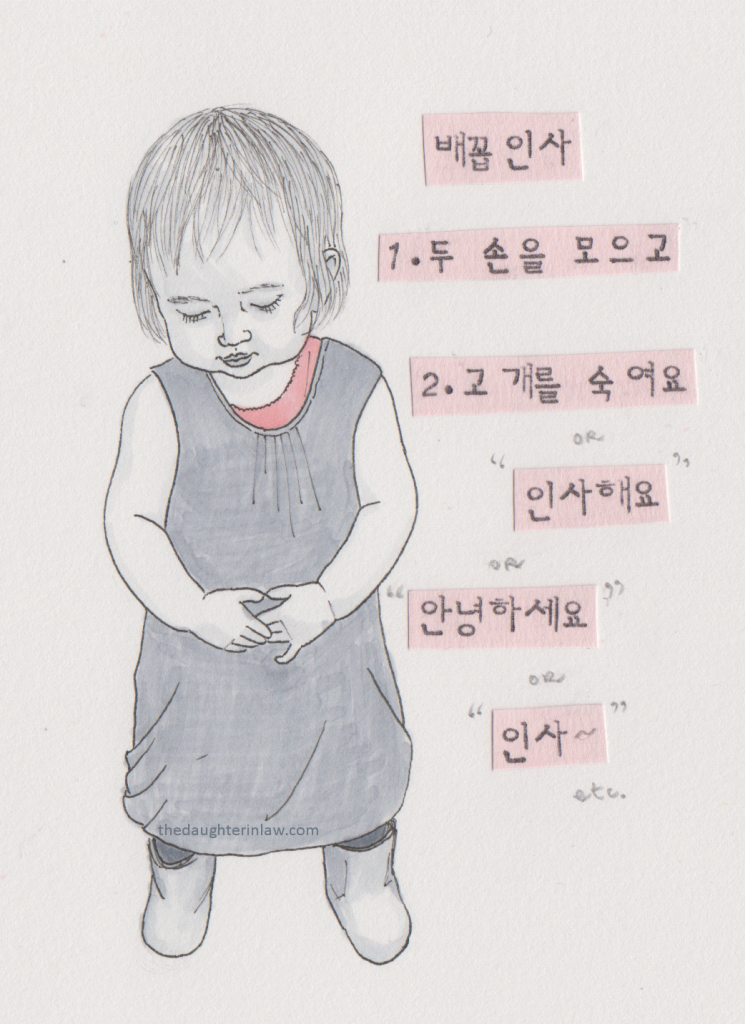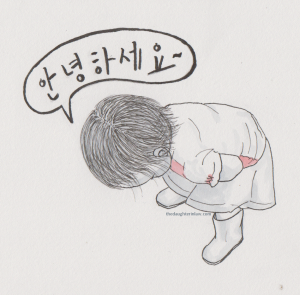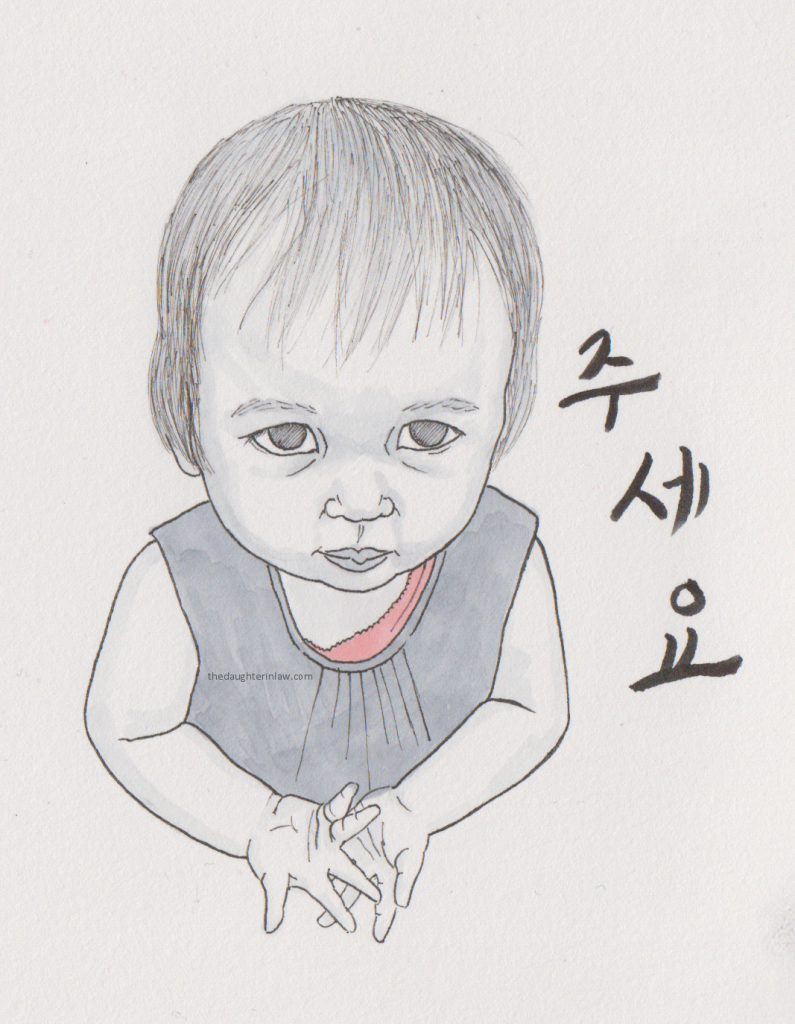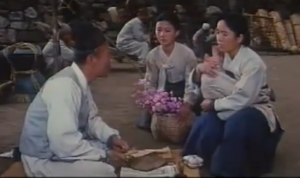(a eulogy and a tale of sharing my own traditions with Han)

The lead up to Christmas is always chaos in my house. This year was no exception, I commemorated Alice’s 20th month with her regular monthly photo, painted a Christmas illustration and had it printed onto personalised cards, finished up my last classes for the year and the last session of Korean playgroup. Alice and I decorated our little Christmas tree, we took our annual Santa photo and Han and I went out and bought our Christmas presents. We had a party at my mum’s house, and Han and I prepared for the most important tradition of the Christmas season..
Singing the 12 Days of Christmas.
Han has spent four Christmases with my family now. Our family is not large, but we well make up for it by noise level and enthusiasm for conversation. Our Christmas is fairly low key these days, we often eat Indian food, and go swimming if it is particularly hot, but we have this one ridiculous tradition that started off one year when my cousin and I found an old, well worn Christmas tea towel at my Grandmother’s house. I suppose we might have been helping dry the dishes, I don’t remember clearly, but the result was, we two enthusiastic girls and our good humoured grandmother, decided it was essential to ceremoniously hold up the tea towel and sing the 12 Days of Christmas, which was printed on it. The first year it was probably just the three of us and perhaps a few siblings or an aunt who happened to be close by, we probably sung it in my Grandfather’s old drafting room, but it became a beloved, important annual tradition, sung with great gusto.
If Han really wanted to impress my family, he would have to learn it in advance, so I spent a few days teaching him, and he was a keen student. My family were so pleased to have another male voice (we are a predominantly female family) and very much appreciated his ability to drag out “FIIIVE GO-OLLLD RRRINGSSS!” to an appropriate excess. It paid off and he has been welcomed back each year since.
This year, as many of you may know, a very important voice was missing from the 12 Days- my Grandmother’s. She passed away just after my birthday and though I’ve sung to her as she slept her final sleep, kissed her beautiful face goodbye, and sat in numb disbelief at her funeral, I haven’t been able to let her go. Anyone who follows this blog would have noticed the delay between posts, I have had to pour all my energy into Alice as it has been a struggle to achieve anything.
When I taught Han the 12 Days of Christmas, he translated the first 5 days into Korean to help him learn the lyrics, and for fun. There was a bit of misunderstanding, and Colly birds became curly birds (곱슬새) but I was always quite amused and impressed by his version.
So, for even more fun, I decided to paint Han’s 5 days of Christmas, as I imagine them from his Korean lyrics. Lately, Alice has this funny little habit where she asks to wear one of our wedding rings on each of her index fingers and then she does a kind of dance with her fingers pointing up, rings hanging on them, before giving them back. My Grandmother never got to see the ring dance. This painting is my tribute to her. If she were still here she probably would have laughed at it with me.
And with this, it’s time to finally say Goodbye, ‘Marnie,’ you were an incredible grandmother, an incredible person and as grand and significant as the sky. You were the foundation of all my childhood memories and remain the essence of childhood to me. Though you lived a long life and died surrounded by loving family, leaving your husband of more than 60 years, four daughters, seven grandchildren, one great granddaughter, and one on the way (my niece or nephew) there was never going to come a day when I was ready for you to go, and your passing has always been the one and only thing beyond the capacity of my imagination. I loved you and love you and am immensely glad that you lived to see me marry and to meet our little Alice. I’m extremely grateful for everything you did for me and all the wonderful times we were able to spend together. You are the definition of a self made woman to me, and I try to follow your example and inspiration in all the things I do.
..And we sang the 12 Days of Christmas, as we do each year. My cousin held up the tea towel, and the sound was definitely not the same, some how it seemed as though we should hear Marnie’s voice among us, though her body was not there. Yet we sang it, and it was ridiculous and beautiful, and I realised it is time to let her go. So here goes.
If you want to try singing Han’s 5 days of Christmas, and you can’t read my handwriting on the illustration, it goes like this:
크리스마스 다섯번째 날 내 사랑이 보내준..
금반지 다섯개!!
네마리 곱슬새,
세마리 프랑스 닭,
두마리 비둘기,
그리고 배나무의 파트리지!
I hope you are having a safe and happy holiday season. We’ve just braved the boxing day sales, which are probably the biggest of the year in Sydney, and I am cleaning up the house in anticipation of a fresh new year. I think it’s going to be a good one!

 Since Alice is competent at bowing her head to greet and thank people, I recently taught her to “배꼽인사” (belly button bow)
Since Alice is competent at bowing her head to greet and thank people, I recently taught her to “배꼽인사” (belly button bow)
 I’ve always felt that good manners are basically essential to getting along well with others in Korea. If I want my daughter to feel comfortable in Korean society as she grows up, teaching appropriate etiquette and manners is really important.
I’ve always felt that good manners are basically essential to getting along well with others in Korea. If I want my daughter to feel comfortable in Korean society as she grows up, teaching appropriate etiquette and manners is really important.
 If you are going to use 포대기, apply the same care and commonsense as when using any other baby carrier or mobility device. I am not an expert on infant physiology and don’t want any harm to come to your child. I’ve also read a few people’s accounts of becoming bow legged from being carried excessively in a 포대기 as an infant. I don’t know whether studies have been done on this, but again, use it carefully and in moderation.
If you are going to use 포대기, apply the same care and commonsense as when using any other baby carrier or mobility device. I am not an expert on infant physiology and don’t want any harm to come to your child. I’ve also read a few people’s accounts of becoming bow legged from being carried excessively in a 포대기 as an infant. I don’t know whether studies have been done on this, but again, use it carefully and in moderation.